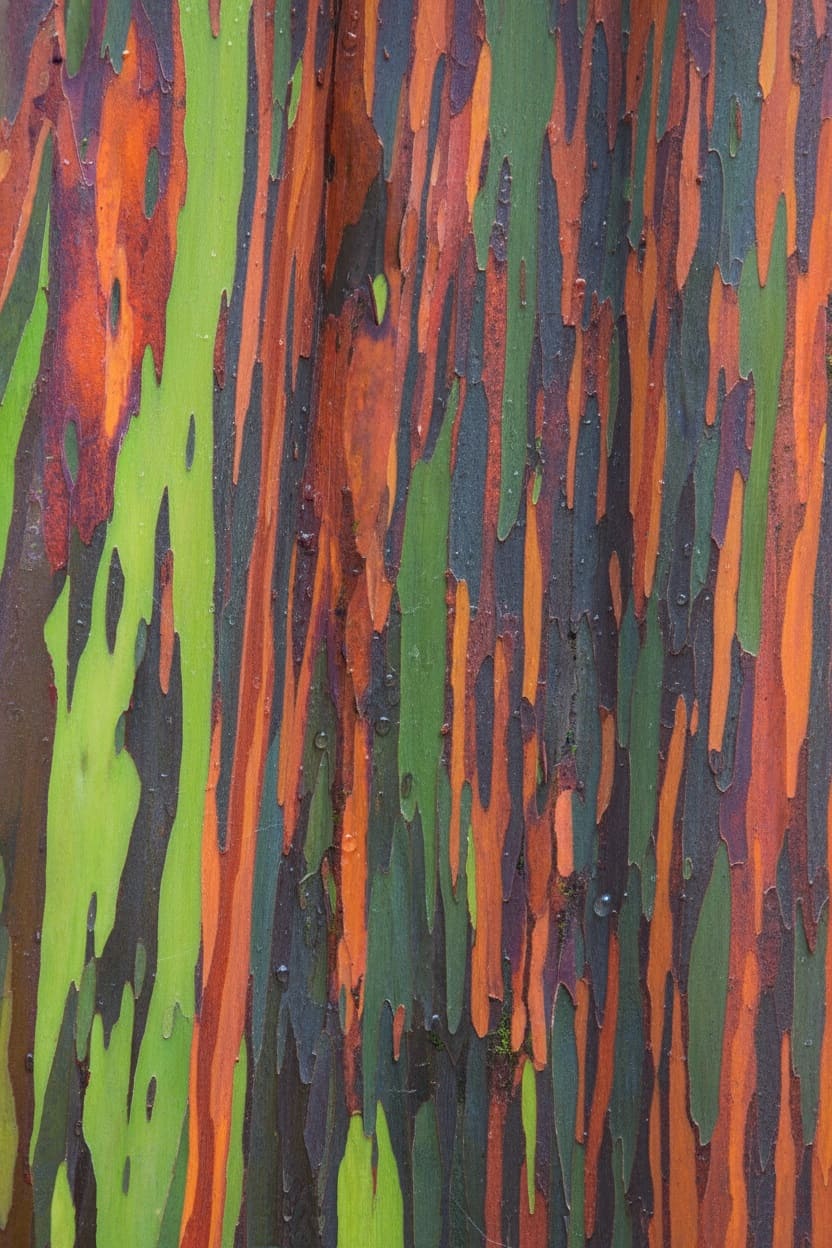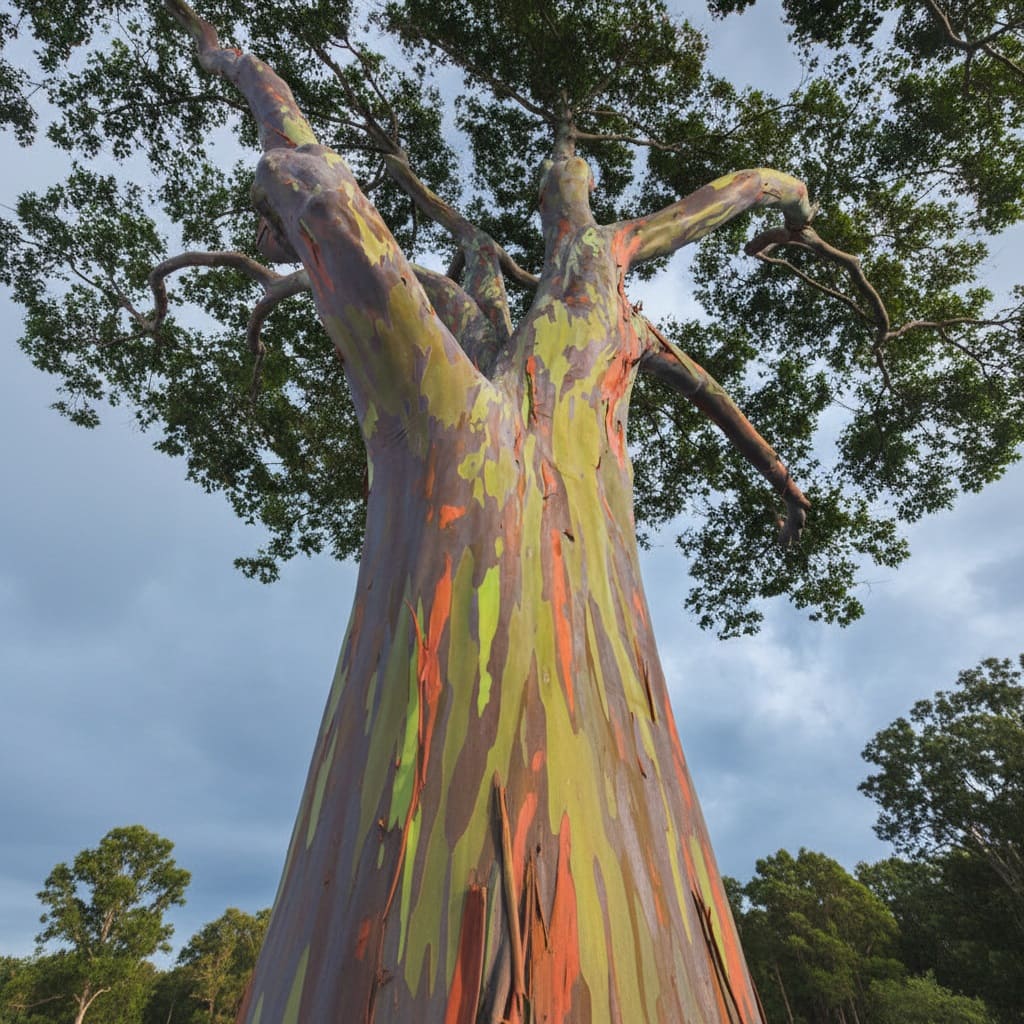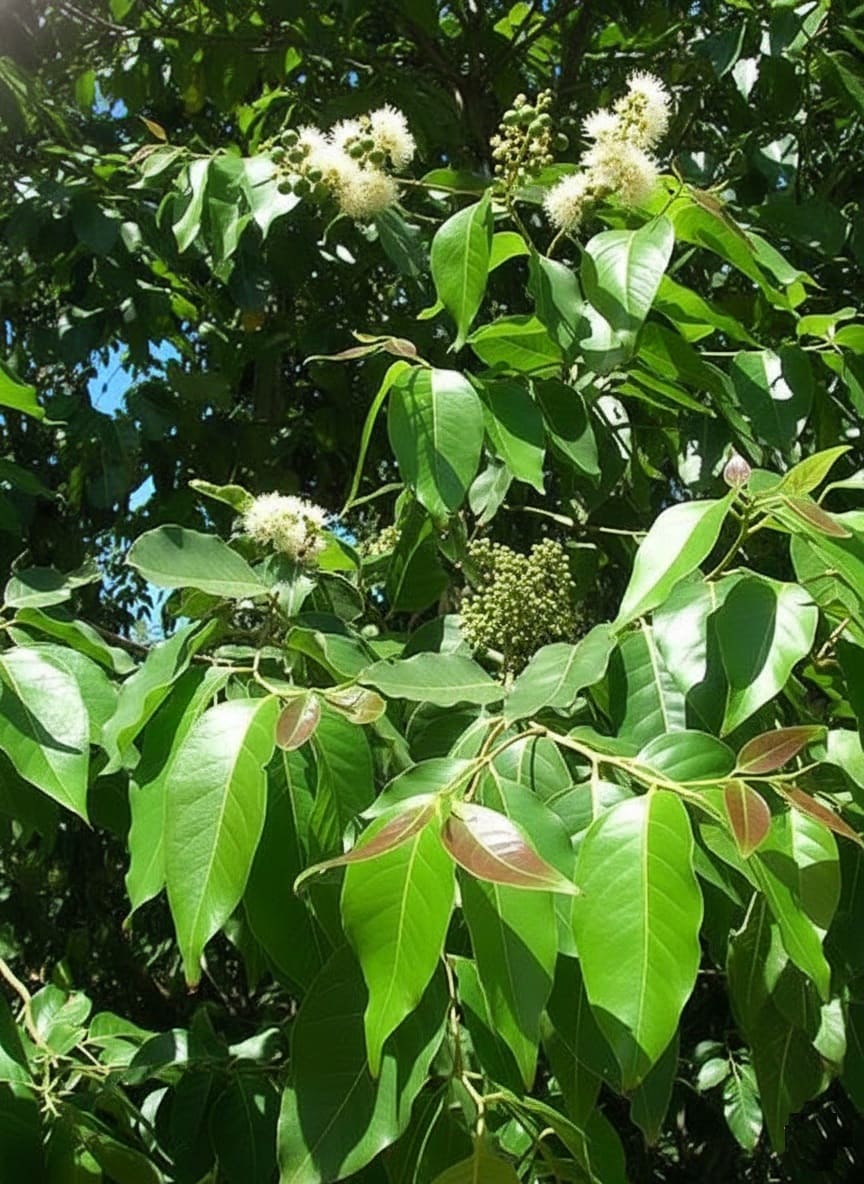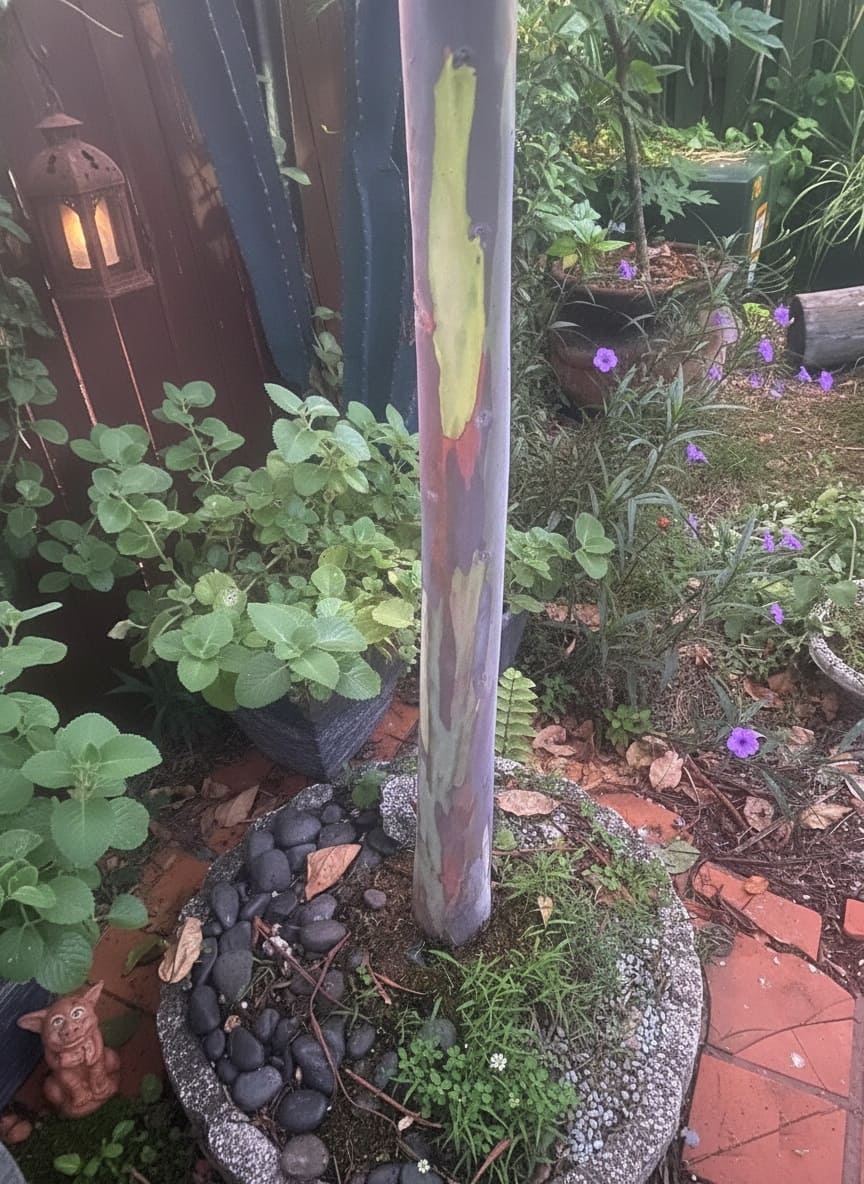Imagine walking through a tropical forest and suddenly encountering a tree trunk that looks like someone melted a sunset onto its bark—vivid stripes of neon green, electric blue, deep purple, and fiery orange spiraling up a towering giant.
Your first thought? Someone’s playing an elaborate prank with paint.
But the rainbow eucalyptus (Eucalyptus deglupta) is completely real, and every spectacular color occurs naturally.
By the end of this guide, you’ll understand the fascinating science behind these living kaleidoscopes, where to find them, and why their story matters far beyond their Instagram-worthy appearance.
Meet the Rainbow Eucalyptus: Nature’s Oddball Eucalypt
The rainbow eucalyptus stands apart from its 700+ eucalyptus cousins in almost every way. While most eucalyptus species hail from Australia’s dry forests, this tree thrives in the steamy rainforests of the Philippines, Indonesia, and Papua New Guinea.
It’s the only eucalyptus species that naturally grows in the Northern Hemisphere and one of just four eucalyptus found outside Australia—a true botanical outlier.
Also known as Mindanao gum or rainbow gum (locally called “bagras” in the Philippines), these trees command attention through sheer presence.
In their native habitat, they rocket skyward to heights of 200-245 feet with trunks spanning up to six feet in diameter and massive buttresses extending 13 feet high.
Even in cultivation outside their native range—like in Hawaii or Florida—they still reach impressive heights of 100-125 feet.
But size alone doesn’t explain their fame. What transforms these trees into natural wonders is their constantly changing, multicolored bark.
The Science Behind the Spectacle
Here’s where biology becomes art. The rainbow effect results from an intricate bark-shedding process that operates on its own unpredictable timeline.
The tree’s smooth outer bark peels away in long, thin strips throughout the year—not all at once, but randomly across different sections.
When bark first strips away, it reveals a bright green inner layer. This isn’t paint or pigment you’re seeing initially, but chlorophyll visible through a transparent surface layer just one cell thick.
Then the transformation begins.
As this newly exposed bark ages and reacts to air and sunlight, biochemical changes create a stunning progression: the bright green darkens to blue, then shifts to purple, transitions through shades of orange and red, and finally settles into a rich brown before the cycle begins anew with the next shedding.
Meanwhile, reddish-brown tannins gradually build up in that thin surface layer, adding depth and complexity to the color changes.
Because different sections shed at different times, mature trees display a patchwork of colors at various stages simultaneously—creating patterns that never repeat. Each tree becomes a unique, ever-changing artwork.
Scientists believe this elaborate shedding process serves a defensive purpose, preventing fungi, lichens, and other organisms from colonizing the trunk and allowing the tree to channel energy into rapid growth.
The spectacular colors are simply a beautiful side effect—nature’s version of accidental genius.
 Find out Why Paint Tree Trunks White? A Guide to Whitewashing for Tree Protection
Find out Why Paint Tree Trunks White? A Guide to Whitewashing for Tree Protection
Built for Speed: Rapid Growth and Structural Features
Rainbow eucalyptus doesn’t just grow—it races skyward at speeds that would make most trees jealous. Young specimens can add 7-10 feet per season, with growth fastest during their first decade.
This explosive growth rate made them valuable for commercial timber plantations, particularly in the Philippines where they’re the dominant species for pulpwood production.
The tree’s architecture reflects its rainforest heritage. Leaves grow in opposite pairs, typically 3-6 inches long, arranged almost horizontally on branches.
The branchlets themselves are unusual—roughly square in cross-section with narrow wings on the corners.
Small cream-colored or pale green flower buds appear in clusters, eventually opening to reveal white to pale yellow stamens. These give way to woody brown seed capsules, each containing 3-12 tiny winged seeds.
With proper conditions, these trees can live 50-150 years, spending decades creating their chromatic displays.
More Than Eye Candy: Ecological and Cultural Significance
Rainforest Keystone Species
In their native habitat, rainbow eucalyptus trees anchor entire ecosystems. Their towering canopies provide nesting sites for birds and shelter for countless species, while their massive root systems stabilize soil and prevent erosion—critical functions in regions prone to heavy rainfall.
When leaves and bark fall, they decompose to enrich the soil, feeding microorganisms and supporting the broader forest community.
Traditional Medicine and Practical Uses
Indigenous communities in the Philippines, Indonesia, and Papua New Guinea have worked with these trees for generations.
The leaves contain natural antiseptic compounds useful for treating wounds, and teas brewed from the leaves help relieve asthma and cough symptoms thanks to anti-inflammatory properties.
The tree’s oils also repel mosquitoes—a valuable benefit in tropical regions where mosquito-borne diseases pose serious health threats.
To make a simple respiratory remedy, locals traditionally steep fresh or dried leaves in hot water for 10-15 minutes, creating a tea with natural decongestant properties.
Beyond medicine, the trees serve economic purposes. The wood provides quality hardwood timber for furniture and construction, while the fast-growing nature makes them ideal for pulpwood plantations producing white paper—an ironic fate for such a colorful tree.
In some regions, people use eucalyptus leaves and bark to create natural dyes for textiles, producing colors ranging from red to amber and gold without requiring chemical mordants.
 Here’s How to Craft Wooden Fence Posts from Farm Trees: A DIY Guide
Here’s How to Craft Wooden Fence Posts from Farm Trees: A DIY Guide
Where to Experience Rainbow Eucalyptus
Southeast Asia: The Native Range
The most vibrant displays remain in the trees’ natural Philippine, Indonesian, and Papua New Guinean rainforests, where ideal humidity and temperature conditions produce the most intense colors.
These trees grow from sea level to elevations around 5,900 feet, thriving in the lowland and lower montane rainforest zones.
Hawaii: America’s Tropical Showcase
Rainbow eucalyptus arrived in Hawaii in 1929 as part of reforestation efforts at Oahu’s Wahiawa Botanical Gardens. They’ve since become iconic features across the islands.
The most photographed grove grows along the road to Hana on Maui near mile marker 7, where mature specimens create a tunnel of color.
The Ke’anae Arboretum on Maui and Keahua Arboretum on Kauai—managed by the University of Hawaii as outdoor classrooms—also host impressive specimens.
Continental Favorites
In frost-free zones of the continental United States, you’ll find rainbow eucalyptus at botanical gardens and parks in Southern California (including the Huntington Botanical Garden in San Marino), Texas, and Florida (particularly Fairchild Tropical Botanic Garden, where the color displays rival those in native habitats).
Pro tip for visitors:
The trees look absolutely stunning after rain when sunlight hits the wet bark, intensifying the colors and creating an almost luminescent effect. Morning light also tends to showcase the colors beautifully without harsh shadows.
Growing Rainbow Eucalyptus: A Reality Check
Captivated and considering planting your own? Here’s what you need to know before ordering seeds.
- Climate is non-negotiable.
These rainforest natives require USDA hardiness zone 10 or higher, with temperatures consistently between 68-72°F and no exposure to frost.
They cannot survive temperatures below 28°F (-2°C), making them viable only in tropical and subtropical climates like Hawaii, southern Florida, and coastal Southern California.
- Space requirements are substantial.
With potential heights exceeding 200 feet and aggressive root systems that can damage foundations, sidewalks, and underground utilities, rainbow eucalyptus belongs only in large, open spaces—parks, estates, or rural properties—not suburban yards.
- Water needs are significant.
These trees can absorb approximately 100 gallons daily, requiring consistent moisture to reach their growth potential. In their native rainforests, abundant rainfall meets these needs naturally.
- Timeline to color:
Young trees take 3-5 years before beginning to display characteristic rainbow coloring. Trees younger than 10 years show more subtle hues than mature specimens.
- Propagation:
Seeds offer the most reliable propagation method. Cuttings work only from trees under 5 years old; after that, root inhibition prevents successful cutting propagation.
For most gardeners, visiting mature specimens at botanical gardens provides the best way to appreciate these trees without the challenges of cultivation.
 Discover The Best Columnar Trees for Privacy, Small Yards & Narrow Spaces
Discover The Best Columnar Trees for Privacy, Small Yards & Narrow Spaces
The Complex Conservation Story
The rainbow eucalyptus presents a modern conservation paradox—threatened in its native range yet potentially invasive where introduced.
Threats at Home
Wild populations face severe pressure from logging, agricultural expansion, and climate change.
Over the past two centuries, the species has experienced an estimated 30% population decline, earning it “vulnerable” status from the International Union for the Conservation of Nature in 2019.
Remaining populations are severely fragmented, making genetic diversity and long-term survival increasingly precarious.
Conservation efforts in the Philippines, Indonesia, and Papua New Guinea focus on habitat preservation, sustainable forestry practices that don’t clear-cut old-growth stands, and legal protections for remaining forest areas.
Concerns in Introduced Regions
In Hawaii, where rainbow eucalyptus was introduced with good intentions, the trees now raise ecological flags.
Their prodigious water consumption can dry out soil, while oils deposited by falling leaves sometimes inhibit water absorption—a troubling combination in water-sensitive ecosystems. In some locations, they outcompete native flora for resources and space.
The key lies in thoughtful placement. Botanical gardens, reforestation projects in appropriate areas, and designated ornamental plantings can showcase these remarkable trees without threatening native ecosystems.
The takeaway isn’t that rainbow eucalyptus is inherently “bad,” but that moving species beyond their native ranges requires careful consideration of ecological consequences.
Protecting wild populations in Southeast Asia while managing introduced populations responsibly represents the balanced approach these trees deserve.
Maximizing Your Rainbow Eucalyptus Experience
Whether you’re planning a trip specifically to see these trees or hoping to spot them during tropical travels, a few insights will enhance your experience:
- Manage expectations about color intensity.
While rainbow eucalyptus genuinely displays natural colors, many online images have digitally enhanced saturation. Real trees show beautiful but somewhat more subtle hues than heavily edited photos suggest.
Trees in ideal tropical conditions display more vibrant colors than those in marginal climates.
- Timing matters less than you’d think.
Because shedding occurs randomly throughout the year rather than seasonally, there’s no specific “best time” to visit. However, recently rained-on bark in sunlight shows colors most vividly.
- Photograph responsibly.
Capture memories without damaging these natural artworks. Stay on designated paths to protect root systems, and never carve into bark—a practice that scars these living canvases and creates disease entry points.
- Support conservation.
When visiting botanical gardens or nature preserves with rainbow eucalyptus, consider donations supporting both living collections and wild habitat protection in the species’ native range.
Frequently Asked Questions
- How long does each color stage last on the bark?
The progression from bright green to brown typically takes several months, though exact timing varies with temperature, humidity, and sunlight exposure.
Because shedding happens continuously across different trunk sections, every stage remains visible simultaneously.
- Can rainbow eucalyptus survive cold winters?
No. These trees are frost-intolerant and cannot survive temperatures below 28°F (-2°C). They require year-round warm, tropical to subtropical conditions.
- Are these trees safe around pets?
Eucalyptus can be toxic to dogs and cats if ingested. Keep pets away from fallen leaves and bark, and supervise them around these trees.
Related posts:
 Creating a Dog-Friendly Garden: Smart Design Tips for Pet Owners
Creating a Dog-Friendly Garden: Smart Design Tips for Pet Owners
 How to Design a Garden That Your Cat Will Love: Essential Tips and Ideas
How to Design a Garden That Your Cat Will Love: Essential Tips and Ideas
- Do they smell like typical eucalyptus?
Surprisingly no. Unlike most eucalyptus species known for strong aromatic oils, rainbow eucalyptus produces minimal oil and lacks that characteristic medicinal scent.
- Where can I buy rainbow eucalyptus seeds or saplings?
Specialized online nurseries and some tropical plant retailers offer seeds. However, confirm your climate is suitable (zone 10+) before purchasing, as these trees cannot adapt to cooler conditions.
- Why is it the only eucalyptus in the Northern Hemisphere?
While most eucalyptus evolved in Australia’s drier climates, Eucalyptus deglupta adapted to tropical rainforests that extend north of the equator in Southeast Asia, making it a unique evolutionary branch of the eucalyptus family.
Why Rainbow Eucalyptus Trees Matter
Beyond their undeniable beauty, these trees represent something larger. They’re living reminders that nature’s creativity exceeds anything we might imagine or design.
- In their native rainforests, they anchor ecosystems and sustain biodiversity.
- In traditional cultures, they provide medicine and practical resources.
- In reforestation projects, they help restore degraded landscapes while sequestering atmospheric carbon.
Yet they also teach humility. The story of rainbow eucalyptus demonstrates that human intervention in natural systems—even well-intentioned—carries complex consequences.
Moving species across continents can create both wonder and problems, requiring us to balance appreciation with ecological responsibility.
The rainbow eucalyptus invites us to marvel while also thinking carefully about our relationship with the natural world.
These trees deserve protection in their native Southeast Asian rainforests and thoughtful management where introduced. Both approaches honor what makes them special while respecting the ecosystems they inhabit.
In essence:
Rainbow eucalyptus creates spectacular colors through natural bark-shedding revealing changing pigments. Native to Southeast Asian rainforests, these fast-growing giants reach 200+ feet and live 50-150 years.
Traditional cultures prize their medicinal properties, while modern conservation efforts balance protecting threatened wild populations against managing introduced trees responsibly.
Hawaii, botanical gardens, and native Philippine, Indonesian, and Papua New Guinean rainforests offer the best viewing opportunities.
Have you encountered a rainbow eucalyptus? Whether you’ve stood beneath these colorful giants or they’re still on your bucket list, share your thoughts or questions in the comments below.
Every conversation about remarkable species like this one helps build appreciation for the natural world’s endless capacity to surprise and inspire us.
Related posts:
- Why Bradford Pear Trees Are Bad for Your Garden: The Invasive Truth
- Unlocking the Benefits of Sugar Maple Trees for Small Farms Beyond Maple Syrup
- How to Grow Mimosa Trees: Essential Planting & Care Tips
source https://harvestsavvy.com/rainbow-eucalyptus-tree/






No comments:
Post a Comment